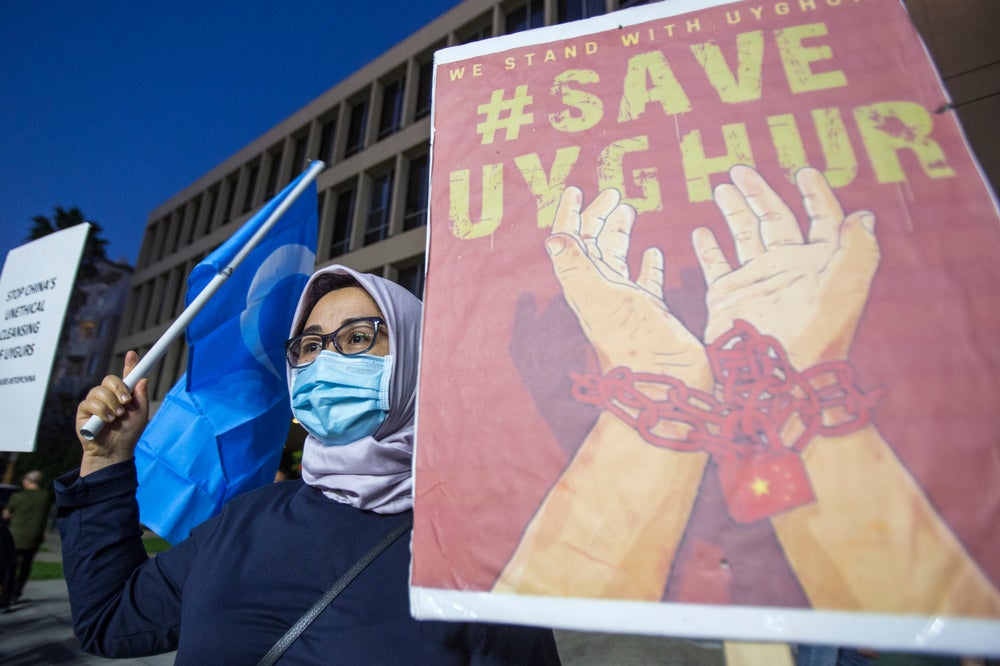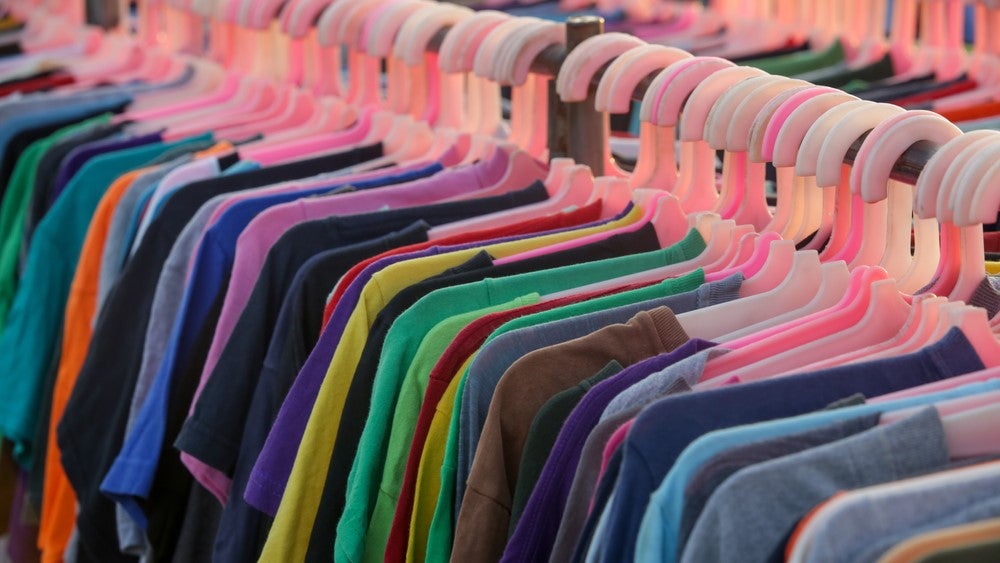The Uyghur Forced Prevention Act (UFPLA) was announced on 23 December 2021, with a 21 June 2022 enforcement date. Since then, US law assumes that all goods produced in China’s Xinjiang region are made with forced labour and are therefore banned from entering the US.
The ban came after the US claimed it had growing evidence that the Chinese government had been exploiting Uyghurs in the northwest of Xinjiang for several years.
In 2020, a study from the Australian Policy Institute alleged that more than 80,000 Uyghurs had been transferred out of Xinjiang between 2017 and 2019 to work in factories, including some sites manufacturing apparel and footwear.
That same year a US bipartisan Congressional-Executive Commission on China released a report on forced labour in the Xinjiang region, detailing its connection to global supply chains.
Representative James McGovern said at the time: “Any US or international company with operations in Xinjiang or working with the Xinjiang government to source labour to other parts of China should reconsider whether they want to be producing products in a region where there is evidence that ‘crimes against humanity’ are being committed.”
McGovern added: “It is long past time for companies to reassess their operations and supply chains in Xinjiang and find alternatives that do not exploit and violate individuals’ human rights.”
What does the UFLPA mean for apparel importers?
According to AI supply chain management firm Certa, China accounts for around 20% of cotton production across the world, with around 90% of the country’s cotton production taking place in its Xinjiang region.
The country also boasts being the largest producer of cashmere with Xinjiang the third-largest producer in the country.
Plus, China plays a dominant role in yarn production. Apparel is amongst the top listed commodities imported into the US from China’s Xinjian Uyghur region which are considered to be at “high risk” of being derived from forced labour in the region, second only to electronics.
Natalie Druckmann, vice president of EMEA at Certa, told Just Style that cotton from the Xinjiang region is a key concern for the apparel sector. She said: “There is widespread evidence of forced labour being used in the sourcing production.”
Druckmann added that a lack of transparency and verification in China is difficult due to political and media restrictions in the country. She said: “Sourcing from China is incredibly difficult without stepping through or passing Xinjiang.”
It’s important to note that anyone importing goods into the US must demonstrate to Customs and Border Protection (CBP) that their products were not made wholly or in part with forced labour, providing “clear and convincing evidence”, in order to get an exception.
Certa’s Druckmann added: “The fact that the CBP cannot prove there was forced labour used within the supply chain is not the point – the burden of proof is the other way around. And that’s much harder to do.”
The UFLPA is also clear that only part of a product needs to have been manufactured in the region in order to be barred from entering the US. Druckmann added: “Even if a single cotton fibre is traced back to Xinjiang the entire product is treated as prohibited.
“It’s incredibly difficult for businesses to know and have sufficient evidence to say that 100% of the product was not made using forced labour.”
Druckmann said that while there are now fewer fashion companies seeing their shipments stopped at the border, there remains a “significant amount” of items still being seized. She added: “The UFLPA requires a really high level of accountability and transparency.”
How many shipments are affected by the rules?
US CBP provides a dashboard, showing the latest statistics on enforcement of the UFLPA. For example, between June 2022 and March 2024, 3,096 shipments were detained, 3,135 released and 1,335 were pending inspection.
Electronics are the most commonly affected product, but 'apparel, footwear and textiles' is the next most affected sector.
In 2023, 430 apparel, footwear and textile shipments into the US were denied entry – that’s 55% of the total inspected, with just 35% (273) later released.
“Enforcement of the UFLPA has been a hit-or-miss proposition designed to instil risk and uncertainty,” Robert Antoshak, partner at Gherzi Textile Organisation, told Just Style. “For some companies it has become a risk management exercise.”
In terms of country of origin, Vietnam had the most apparel, footwear and textile products reviewed at CBP in 2023, with China in second place.
How is the UFPLA changing global supply chains?
“The UFLPA has had a chilling effect on the operations of many clothing companies, while earning a collective shrug from others. Of course, these reactions reflect exposure to sourcing out of China or tolerance for risk," Antoshak told Just Style.
There have already been a number of high-profile apparel companies seeing shipments detained by the US' CBP.
In 2021, Fast Retailing-owned brand Uniqlo had a shipment of cotton shirts seized by CBP in Los Angeles after the company did not provide sufficient evidence to prove the items had been produced completely free of forced labour.
Fast Retailing stated the items were manufactured in China using raw cotton materials sourced outside of the country and had presented certificates of origin for the items, but the documentation was not accepted by CBP.
A Fast Retailing statement published at the time said: “While we maintain that appropriate documentation has been submitted on this occasion, we would like to emphasise that we appreciate the support from our valued business and government partners in helping us to continue to conduct business in an appropriate manner globally.
“Uniqlo looks forward to continued support and cooperation in connection with our ongoing importation of responsibly-sourced products. We will continue to work with the CBP and take the appropriate measures to ensure the continued smooth importation of our products.”
The UFLPA's introduction in 2022 has played a role in shifting wider apparel manufacturing trends.
“The UFLPA has hastened a shift in global sourcing that began before the pandemic, accelerated during and after the pandemic and now seems standard practice for many companies,” Antoshak explained.
He added that Vietnam, Bangladesh and other countries are now emerging as significant sourcing hubs, reporting a growth in exports while sourcing from China “remains relatively flat”.
“Interestingly, exports of yarn and fabrics from China and elsewhere in Asia to the Caribbean and Mexico have risen to tap nearshoring of clothing. Where these inputs contain cotton banned by the UFLPA is up to the US Customs to sort through,” Antoshak added.
Business as usual?
Since the UFLPA’s enforcement in 2022, the National Council of Textile Organizations (NCTO) claims cotton production in Xinjiang has increased, however the number of shipments being stopped and inspected by CBP has actually decreased.
While $185bn of apparel, textile and footwear products were imported into the US in 2022, just $35m of this was detained by CBP, added NCTO's president and CEO, Kim Glas.
Writing for Just Style in 2023, she maintained: “The lack of an effective enforcement programme combined with existing loopholes within our trading system has created the world’s greatest black market, serving as a gateway to facilitate forced labour products, dangerous goods, such as fentanyl, and counterfeit materials to our doorsteps."
Many apparel importers take advantage of a provision in US law called Section 321 de minimis waivers when shipping apparel products into the US. The de minimis rule allows for duty-free import of goods valued under $800 per day by a single entity, with most going uninspected.
Glas claimed this is “effectively handing a free trade agreement to China and the rest of the world”.
She also alleged that the exploitation of this loophole alone has allowed Chinese ecommerce distributors to build "empires virtually killing US manufacturing jobs overnight".
In January 2024, NCTO urged the Department of Homeland Security to step up its enforcement of the UFLPA and the de minimis loophole, saying it is destroying US apparel manufacturing.
With both Joe Biden and Donald Trump taking a tough line on Chinese imports, it's likely that enforcement of the UFLPA and the de minimis rule will remain key talking points.
















